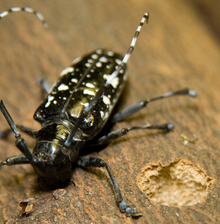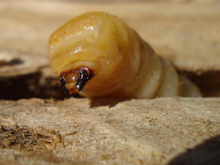Quick facts
Asian longhorned beetle is an invasive species.
- Asian longhorned beetles prefer hardwood trees, such as maple, ash and birch.
- Adults and larvae feed on living host trees.
- The tree’s structural strength is impaired by the tunneling.
- Larvae can girdle and kill trees.
The Minnesota Department of Agriculture monitors this invasive species. Please report any Asian longhorned beetles you spot at Report a Pest.
How to identify Asian longhorned beetles
- Asian longhorned beetles (Anoplophora glabripennis) adult beetles have long black and white banded antennae and a black body with irregular white blotches.
- They can be 1 to 1-1/2 inches long.
- Larvae are off-white with a brown head and can grow to 2 inches long.
Life cycle
- Females chew oval grooves in the bark of host trees where they lay rice-size eggs.
- They can lay 25 to 40 eggs during the length of their adult lives.
- They begin to feed on the cambium layer, burrowing deeper into the tree during winter months.
- Adults make their way out by carving a large, pencil-size hole that is perfectly round.
Reviewed in 2019



